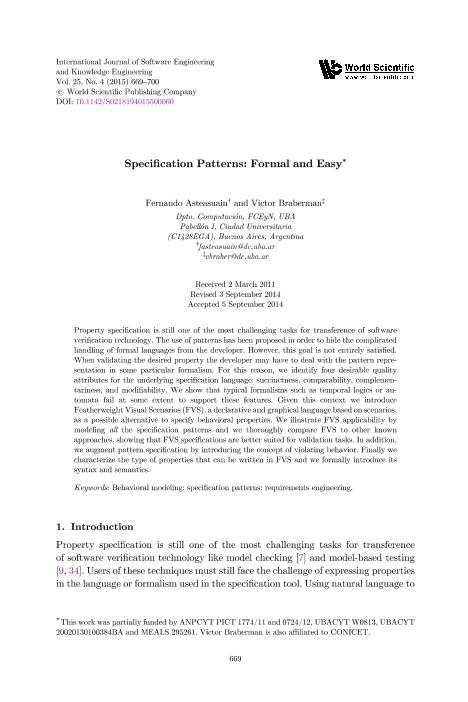Artículo
Specification Patterns: Formal and Easy
Fecha de publicación:
05/2015
Editorial:
World Scientific
Revista:
International Journal Of Software Engineering And Knowledge Engineering
ISSN:
0218-1940
Idioma:
Inglés
Tipo de recurso:
Artículo publicado
Clasificación temática:
Resumen
Property specification is still one of the most challenging tasks for transference of software verification technology. The use of patterns has been proposed in order to hide the complicated handling of formal languages from the developer. However, this goal is not entirely satisfied. When validating the desired property the developer may have to deal with the pattern representation in some particular formalism. For this reason, we identify four desirable quality attributes for the underlying specification language: succinctness, comparability, complementariness, and modifiability. We show that typical formalisms such as temporal logics or automata fail at some extent to support these features. Given this context we introduce Featherweight Visual Scenarios (FVS), a declarative and graphical language based on scenarios, as a possible alternative to specify behavioral properties. We illustrate FVS applicability by modeling all the specification patterns and we thoroughly compare FVS to other known approaches, showing that FVS specifications are better suited for validation tasks. In addition, we augment pattern specification by introducing the concept of violating behavior. Finally we characterize the type of properties that can be written in FVS and we formally introduce its syntax and semantics.
Palabras clave:
BEHAVIORAL MODELING
,
REQUIREMENTS ENGINEERING
,
SPECIFICATION PATTERNS
Archivos asociados
Licencia
Identificadores
Colecciones
Articulos(OCA CIUDAD UNIVERSITARIA)
Articulos de OFICINA DE COORDINACION ADMINISTRATIVA CIUDAD UNIVERSITARIA
Articulos de OFICINA DE COORDINACION ADMINISTRATIVA CIUDAD UNIVERSITARIA
Citación
Asteasuain, Fernando; Braberman, Victor Adrian; Specification Patterns: Formal and Easy; World Scientific; International Journal Of Software Engineering And Knowledge Engineering; 25; 4; 5-2015; 669-700
Compartir
Altmétricas




